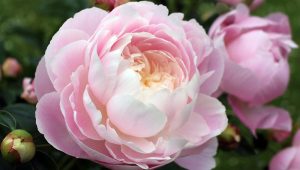Peony: An Old-Fashioned, Easy-Care Beauty
Picture this: A blooming bush with flowers as heartbreakingly beautiful as roses that deer won’t touch, that love the extended cold of our foothill winters, and that can live up to 100 years. Pure fantasy? Nope. Let me introduce you to the amazing peony.
Beloved in old-fashioned cutting gardens, the peony is the official flower of China, the state of Indiana, and the 12th wedding anniversary. The plant was used in ancient times for medicinal purposes, when it was thought to soothe headaches and treat asthma.
Most garden peonies are perennial hybrids native to China, but species of peonies are found in Asia, southern Europe and the western United States. Peonies grow to a neat, rounded bush from two to four feet tall with large, dark green leaves that make it attractive even when not in bloom. But speaking of blooms, they are spectacular, coming in every color except blue and unfurling in spring or early summer, depending on the variety. Many peony flowers look a lot like the centifolia or “cabbage” roses, which pack up to 100 petals per bloom. The difference is that some peony flowers can reach 10 inches across. A few are fragrant, reminiscent of old-fashioned roses.
The most widely-available garden types are herbaceous and tree peonies. Herbaceous peonies die back to the ground each fall, while tree peonies have permanent woody branches. Peonies do best in Zones 7 to 9 and prefer full sun; however, in areas with extremely hot summers (like ours), it’s best to situate them so they get light afternoon shade. They don’t like to dry out, but I’ve found if they get a little shade in the afternoon and are generously mulched, they require only moderate water.
While peonies are relatively carefree once established, they are very persnickety about how they are planted. Site preparation is everything. They prefer relatively rich, deep soil that is amended then regularly fed with phosphorus. And here’s the real deal-breaker: their thick roots must never be planted too deeply, or they won’t flower. Make sure to read up on the variety you choose; one inch difference in planting depth can make your plant refuse to bloom. As with most perennials, it’s best to plant in fall, several weeks before the first expected frost.
I have found peonies to be relatively pest free—and that includes deer. My peonies are almost 20 years old and not once have the neighborhood deer touched them. Nor have they ever been attacked by insects or snails. There is a curious thing that happens with ants, though. The year my peonies first bloomed I saw the fat round buds covered in ants. At first I freaked because I knew about the symbiotic relationship between ants and aphids. But the aphids never came. I later learned that experts speculate the buds secrete some kind of “nectar” the ants harvest; then once the flower fully opens, the ants depart. Some think the peony might produce this substance to enlist the ants’ help in opening the buds. Whether or not this is true, what is true is that the ants do no harm.
Now, about the peony that is native to the western U.S: It’s called P. Brownii (with a subspecies called P. Californica) and grows in dry sagebrush and Ponderosa pine country in the West. It doesn’t put on a flower show as dramatic as the Asian hybrids, but it has its own subtle beauty. I’ve never seen the native in nurseries but have read they can be grown from seed. If you’d like to try, the California Native Plant Society (CNPS) site offers photos of the plant and has a short list of seed companies that carry them: http://calscape.org/Paeonia-brownii.
A long-lived, nearly pest-free beauty that thrives in my foothills garden? Count me in.
Rachel Oppedahl is a University of California Cooperative Extension Master Gardener of Tuolumne County.
UCCE Master Gardeners of Tuolumne County can answer home gardening questions. Call 209-533-5912 or go to: http://ucanr.edu/survey/survey.cfm?surveynumber=7269 to fill out our easy-to-use problem questionnaire. Check out our website at: http://cecentralsierra.ucanr.edu/Master_Gardeners/ You can also find us on Facebook.

